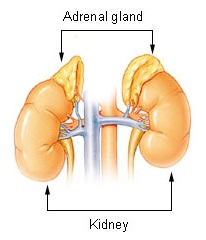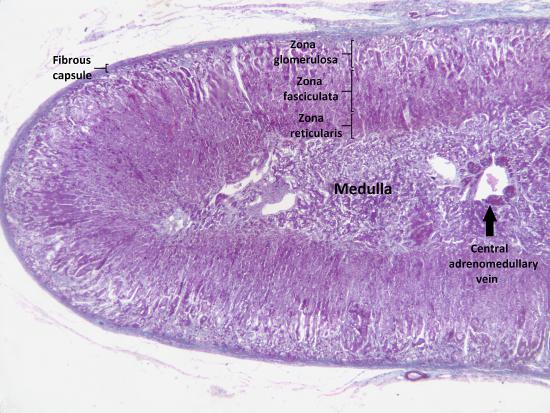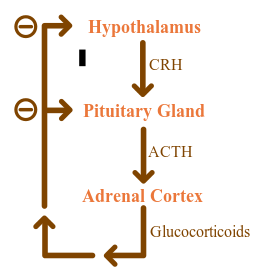12.6: Adrenal Glands
- Last updated
- Save as PDF
- Page ID
- 30707
Eek!
Being bitten on the nose by an eel certainly qualifies as a frightening experience! The fear this man is experiencing produces the same physiological responses in most people— racing heart, rapid breathing, clammy hands. These and other fight-or-flight responses prepare the body to either defend itself or run away from danger. Why does fear elicit these changes in the body? The responses occur in large part because of hormones secreted by the adrenal glands.

Introduction to the Adrenal Glands
The adrenal glands are endocrine glands that produce a variety of hormones. Adrenal hormones include the fight-or-flight hormone adrenaline and the steroid hormone cortisol. The two adrenal glands are located on both sides of the body, just above the kidneys, as shown in Figure \(\PageIndex{2}\). The right adrenal gland (on the left in the figure) is smaller and has a pyramidal shape. The left adrenal gland (on the right in the figure) is larger and has a half-moon shape.

Each adrenal gland has two distinct parts, and each part has a different function, although both parts produce hormones. There is an outer layer, called the adrenal cortex, which produces steroid hormones including cortisol. There is also an inner layer, called the adrenal medulla, which produces non-steroid hormones including adrenaline.
Adrenal Cortex
The adrenal cortex, or the outer layer of the adrenal gland, is divided, in turn, into three additional layers, called zones (Figure \(\PageIndex{3}\)). Each zone has distinct enzymes that produce different hormones from the common precursor molecule cholesterol, which is a lipid.
- Zona glomerulosa is the outermost layer of the adrenal cortex. It lies immediately under the outer fibrous capsule that encloses the adrenal gland.
- Zona fasciculata is the middle layer of the adrenal cortex. It is the largest of the three zones, accounting for nearly 80 percent of the adrenal cortex.
- Zona reticularis is the innermost layer of the adrenal cortex. It is directly adjacent to the medulla of the adrenal gland.

Types of Adrenal Cortex Hormones
Hormones produced by the adrenal cortex are called corticosteroids. As steroid hormones, corticosteroids are endocrine hormones that are made of lipids and exert their effects on target cells by crossing the plasma membrane and binding with receptors within the cytoplasm. A steroid hormone and its receptor form a complex that enters the cell nucleus and affects gene expression. There are three types of corticosteroids synthesized and secreted by the adrenal cortex. Each type is produced by a different zone of the adrenal cortex, as shown in Figure \(\PageIndex{3}\).
Mineralocorticoids
Mineralocorticoids are produced in the zona glomerulosa and include the hormone aldosterone. These hormones help control the balance of mineral salts (electrolytes) in the body. In the kidneys, aldosterone increases the reabsorption of sodium ions and the excretion of potassium ions. Aldosterone also stimulates the retention of sodium ions by cells in the colon and by the sweat glands. The amount of sodium in the body affects the volume of extracellular fluids including the blood and thereby affects blood pressure. In this way, mineralocorticoids help control blood volume and blood pressure.
Glucocorticoids
Glucocorticoids are produced in the zona fasciculata and include the hormone cortisol, which is released in response to stress and is considered the primary stress hormone. Glucocorticoids help control the rate of metabolism of proteins, fats, and sugars. In general, they increase the level of glucose and fatty acids circulating in the blood. Cells rely primarily on glucose for energy, but they can also use fatty acids for energy as an alternative to glucose. Glucocorticoids are also involved in the suppression of the immune system, having a potent anti-inflammatory effect. In addition, cortisol reduces the production of new bone and decreases the absorption of calcium from the gastrointestinal tract.
Androgens
Androgens are produced in the zona reticularis and include the hormone DHEA (dehydroepiandrosterone). Androgens are a general term for male sex hormones, although this is somewhat misleading as adrenal cortex androgens are produced by both males and females. In adult males, they are converted to more potent androgens such as testosterone in the male gonads (testes). In adult females, they are converted to female sex hormones called estrogens in the female gonads (ovaries).
Regulation of Adrenal Cortex Hormones
Steroid hormone production by the three zones of the adrenal cortex is regulated by hormones secreted by the anterior lobe of the pituitary gland as well as by other physiological stimuli. For example, the production of glucocorticoids such as cortisol is stimulated by adrenocorticotropic hormone (ACTH) from the anterior pituitary, which in turn is stimulated by corticotropin releasing hormone (CRH) from the hypothalamus. When levels of glucocorticoids start to rise too high, they provide negative feedback to the hypothalamus and pituitary gland to stop secreting CRH and ACTH, respectively. This negative feedback mechanism is illustrated in Figure \(\PageIndex{4}\). The opposite occurs when levels of glucocorticoids start to fall too low.

Adrenal Medulla
The adrenal medulla is at the center of each adrenal gland and is surrounded by the adrenal cortex. It contains a dense network of blood vessels into which it secretes its hormones. The hormones synthesized and secreted by the adrenal medulla are called catecholamines, and they include adrenaline (also called epinephrine) and noradrenaline (also called norepinephrine). These are water-soluble, non-steroid hormones are made of amino acids. As non-steroid hormones, they cannot cross the plasma membrane of target cells. Instead, they exert their effects by binding to receptors on the surface of target cells. The binding of hormones and receptors activates an enzyme in the plasma membrane that controls a second messenger. It is the second messenger that influences processes inside the cell.
Catecholamines function to produce a rapid response throughout the body in stressful situations. They bring about such changes as increased heart rate, more rapid breathing, constriction of blood vessels in certain parts of the body, and an increase in blood pressure. The release of catecholamines by the adrenal medulla is stimulated by activation of the sympathetic division of the autonomic nervous system.
Disorders of the Adrenal Glands
Disorders of the adrenal glands generally include either hypersecretion or hyposecretion of adrenal hormones. The underlying cause of the abnormal secretion may be a problem with the adrenal glands or with the pituitary gland, which controls adrenal cortex hormone production. Both adrenal and pituitary glands are subject to the formation of tumors, which may cause adrenal disorders. The adrenal gland may also be affected by infections or autoimmune diseases.
Adrenal Hypersecretion: Cushing’s Syndrome
Hypersecretion of the glucocorticoid hormone cortisol leads to a disorder named Cushing’s syndrome. The most common cause of Cushing’s syndrome is a pituitary tumor, which causes excessive production of ACTH. The disease produces a wide variety of signs and symptoms, which may include obesity, diabetes, high blood pressure (hypertension), excessive body hair, osteoporosis, and depression. A distinctive sign of Cushing’s syndrome is the appearance of stretch marks in the skin, as the skin becomes progressively thinner. Another distinctive sign is a moon face shown in the section Introduction to the Endocrine System, in which fat deposits give the face a rounded appearance. Treatment of Cushing’s syndrome depends on its cause and may include surgery to remove a tumor or medications to suppress the activity of the adrenal glands.
Adrenal Hyposecretion: Addison’s Disease

Hyposecretion of the glucocorticoid hormone cortisol leads to a disorder named Addison’s disease. There may also be hyposecretion of mineralocorticoids with this disorder. Addison’s disease is generally an autoimmune disorder, in which the immune system produces abnormal antibodies that attack cells of the adrenal cortex. Untreated infections, especially of tuberculosis, may also damage the adrenal cortex and cause Addison’s disease. A third possible cause is the decreased output of ACTH by the pituitary gland, generally due to a pituitary tumor. A distinctive sign of Addison’s disease is hyperpigmentation of the skin (Figure \(\PageIndex{5}\)). Other symptoms tend to be nonspecific and include excessive fatigue. Addison’s disease is generally treated with replacement hormones in pill form.
Feature: My Human Body

Does just looking at this photo cause you to break out in a cold sweat and experience heart palpitations? Imagine how scary it would be to fling yourself backward off a tall building like the BASE jumper in the photo. There would be very little time to use a parachute to slow your fall before you hit the ground. BASE jumping is called the most dangerous sport on Earth. In fact, it is so dangerous that it is outlawed in some places.
People who participate in such dangerous activities as BASE jumping are likely to be adrenaline “junkies.” They are addicted to the adrenaline rush and euphoria, or “high,” it causes when their fight-or-flight response is triggered by danger. Why does adrenaline have this effect? Adrenaline is closely related to dopamine, a chemical messenger in the brain that plays a major role in pleasure and addiction.
Adrenaline addicts don’t have to participate in BASE jumping or other dangerous sports to get an adrenaline rush. They might choose a dangerous occupation such as firefighting, participate in risky behaviors such as reckless driving or bank robbing, or just pick fights with other people. They might even create their own stress by always taking on too much work or delaying projects until close to their deadline.
While some excitement in one’s life is generally a good thing, always putting oneself in danger or constantly being under stress are obviously not good things. If you think you might be an adrenaline addict, note that there are healthier ways to experience a hormonal “high.” Running, biking, or participating in some other form of vigorous aerobic exercise causes the pituitary gland and hypothalamus to produce opiate-like endorphins, leading to a so-called “runner’s high.” Like the euphoric feeling adrenaline causes, a runner’s high may last for hours.
Review
- Describe the structure and location of the adrenal glands.
- Compare and contrast the adrenal cortex and adrenal medulla.
- Identify the three layers of the adrenal cortex and the type of hormones each layer produces.
- Give an example of each type of corticosteroid and state its function.
- Explain how the production of glucocorticoids is regulated.
- What is a catecholamine? Give an example of a catecholamine and state its function.
- Compare and contrast Cushing’s syndrome and Addison’s disease.
- Cortisol is a type of:
- Corticosteroid
- Mineralocorticoid
- Glucocorticoid
- A and C
- True or False. The adrenal glands help regulate the body’s stress response and reproductive functions.
- True or False. The left adrenal gland produces steroid hormones, while the right adrenal gland produces non-steroid hormones.
- Would it help to give someone with Cushing’s syndrome more ACTH? Explain your answer.
- What are two ways in which the nervous system (which includes the brain, spinal cord, and nerves) controls the adrenal gland?
- If the level of cortisol rises too high, the amount of CRH secreted will normally:
- not change
- become excessively high
- become slightly higher
- decrease
- Noradrenaline is also called:
- norepinephrine
- adrenaline
- adrenocorticotropin
- glucocorticoid
- Explain why a pituitary tumor can cause either hypersecretion or hyposecretion of cortisol.
Explore More
Learn more about the effects of stress and cortisol on the brain here:
Attributions
- Attack by Jerry Kirkhart, CC BY 2.0 via Wikimedia Commons
- Adrenal gland by cancer.gov, public domain via Wikimedia Commons
- Adrenal cortex labeled by Jpogi, CC0
- ACTH Negative Feedback by DRosenbach; CC BY-SA 3.0 via Wikimedia Commons
- A 69 Year Old with Tiredness and a Persistent; CC BY 2.5; Petros Perros via Wikimedia Commons
- Base Jump by Kontizas Dimitrios; CC BY-SA 3.0 via Wikimedia Commons
- Text adapted from Human Biology by CK-12 licensed CC BY-NC 3.0


